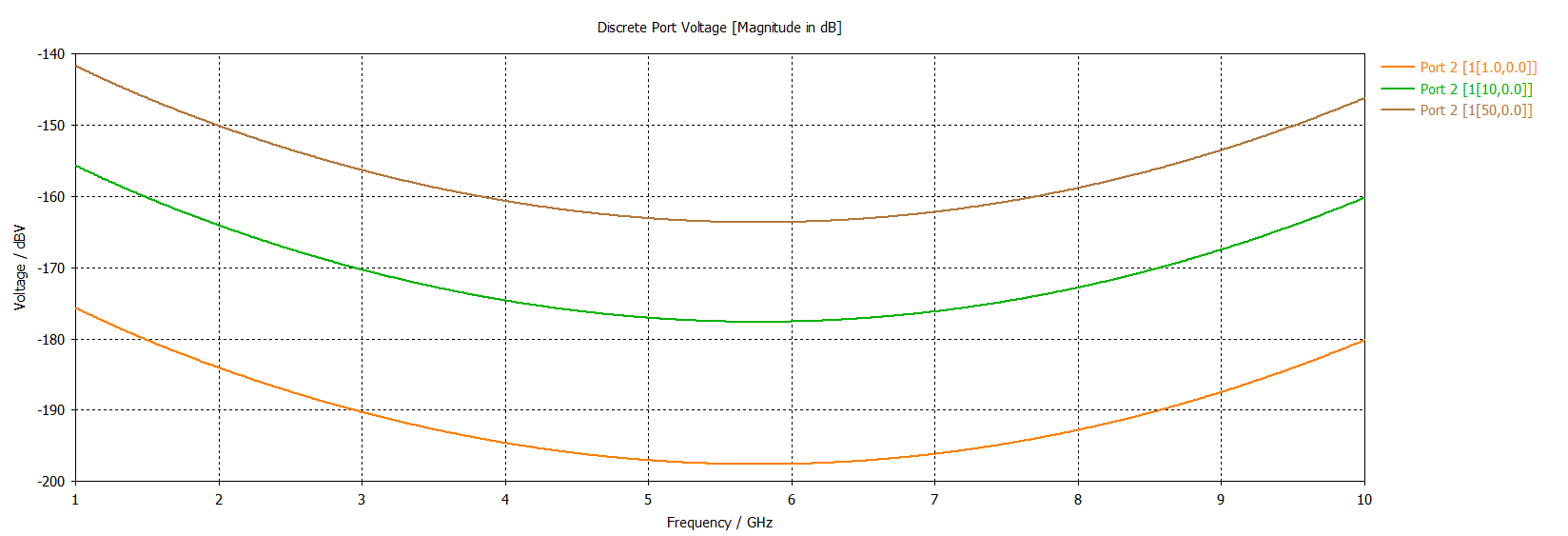Measuring propagation loss between two dipoles over free space
I am trying to simulate 2 dipole antennas in CST. Both dipoles utilize discrete ports as the source, with only one of them excited to achieve a TX-RX setup. I am interested in viewing the dB received by the RX antenna over a frequency range of 1GHz-10GHz. I am using the time domain solver. When the antennas are set up closer together the results are as expected, but once the distance is greater than 5ft the RX antennas does not receive any transmission. Is this a limit of CST itself, are there any settings I can tweak to get results at that distance, or is there something wrong with my setup?
Here are the parameters for the dipoles:
and one of the dipoles
Have you looked at the time signals? Simulation time long enough for the signal to travel that distance?
What do you mean by "does not receive any signal" ? What level of signal are you expecting? What is your tx signal strength, and how are you feeding the fake dipole? What is the rx side look like?
The TX signal is set at an amplitude of 1A.
The TX antenna produces the following signal:
but the RX port doesn't register it:
I'm not sure what you mean by how I'm feeding the fake dipole? It has a discrete port on it as well except with no excitation.
When I bring the antennas closer I do receive power on the RX antenna.
Where do I modify the time signals?
Where do I modify the time signals? I'm using the time domain solver.
There is a solver setting that determines (limits) the maximum number of time steps. If this is too low, your simulation will stop before the excitation pulse has reached the receive antenna. Check time signals in results.
I'm trying to obtain the propagation loss between two dipole antennas at a distance of 10m. The goal is to perform a sweep of 1-10GHz and measure the propagation loss by viewing the power received by the passive second dipole antenna (RX). I created two dipole antennas and set them 10m away, but for some reason when the simulation completes the power received by the RX antenna is displaying 0dB received. I have performed this experiment in real life and there should be some power received by the RX antenna.
I am using the Time Domain Solver, but I'm not sure if this is the correct way of doing it. Almost all settings are left in default except the changes needed to create the antennas. I've tried a multitude of set ups but the result is always the same: 0dB on the RX antenna. Both antennas are identical, but I'm only exciting Port 1 and simply leaving Port 2 as is in order to have it act as a load. Is this the correct approach? I am very new to CST and I'm not entirely sure if I'm going about this correctly.
I presume you don't mean 0 dB received but -infinity dB or zero power.
Let me repeat: Most likely, this does not work, because the default settings are not made for models that are so large compared to the wavelength. Time tomains solvers only simulate a limited period of time, and if your travel time between the antennas is larger than that time limit, you have zero signal at the receive antenna. So you might need to adjust that time steps limit, instead of using the defaults.
Let me repeat: You can find out by checking time signals, i.e. port voltage vs. time
Google for "cst time steps limit"
Hey, thanks for your advice! Apologies for repeating myself, that reply was meant to be a new, better structured post but the mods posted it here instead.
So I looked into changing the step time limit, sadly to no results. With a time limit of 204ns and the antennas 6ft apart, the RX antenna did display some propagation loss. Here are the measurements at 1, 10, and 50 amplitude for the antennas at about 6ft.

I moved the antennas just one foot farther apart (now 7ft apart) then increased the time limit to 408, 1000, and even to 5000 (which of course shouldn't be necessary). Every single time the dB were negatively infinite, showing that no power whatsoever form Port 1(TX) reached Port 2(RX).
I need to be able to measure the propagation loss at a greater distance than 7ft. Does CST just not have the capability to perform these type of measurements at that distance, or is there something else I'm missing?
I've: increased step time limit, increased the amplitude, excited only the TX antenna (Port 1), tried changing from step time limit to distance limit, to no avail. Once I go past 7 ft the RX antenna won't receive any signal from the TX antenna.
Any advice would be appreciated.
Let's do a quick calculation: 6ft is 1.83m. At speed of light, the signal takes 1.83m/3e8m/s = 6.1ns so the 204ns time limit is fine. So this is not the issue.
Maybe you should talk to CST support.
If the antennas are away from the near-field zone of one another (~15 cm at 1 GHz, less at higher freqs), why don't you just use the Gain pattern for the dipole, find the gain at each freq associated with the direction of the other antenna, and apply the Friis formula? If there is no other scattering geometry, why waste the time trying to compute the coupling with a field solver?
- Return loss and phase graph how to interpret
- Is core loss in an inductor proportional to it's inductance value?
- Computing metallic losses for coplanar waveguide | HFSS
- how can I calculate the returnloss theoritically depending on the simulation results
- Core loss, proximity and skin loss
- How big is core losses in an inductor at 40kHz?
